Tamron 70-200mm f2.8 VC review
-
-
Written by Thomas
Intro
The Tamron SP 70-200mm f/2.8 VC is the company’s first 70-200mm f2.8 equipped with optical stabilization. Announced for the Canon-mount in November 2012 and for the Nikon-mount in March 2013, it covers a 2.9x zoom-range. Tamron decided to price its new zoom right between the 70-200mm f2.8 pro options from Canon or Nikon and the competition from Sigma.
A constant f2.8 aperture combined with a 70-200mm zoom range is sought after by photographers who need to capture fast moving action that is a little further away or isolate their subject with a shallow depth of field. You can frame a person full-hight in landscape orientation from around 17m distance on a full-frame body or from 25m distance on a DX-body. On a DX-sensor the lens gives you an equivalent 105-300mm coverage plus future-proofing should you upgrade to an FX-body at a later date.
In my Tamron 70-200mm f/2.8 VC review I’ll put this zoom to the test on a 36MP Nikon D800 body to see whether it’s a good match for the highest resolution full-frame DSLR. This review also comes after my in-depth Nikon 70-200mm f2.8G VR II review, and Sigma 70-200mm f2.8 OS review so I’ll be able to tell you the pros and cons of these models to help you choose which will be the best telephoto zoom for you.
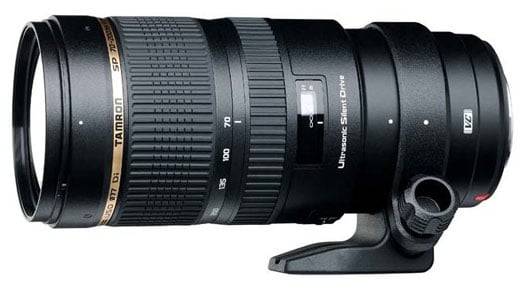 |
Facts from the catalog
As usual I’ll have a look at the technical data first. I’ve rated the features with a [+] (or [++]), when it’s better than average or even state of the art, a [0] if it’s standard or just average, and [-] if there’s a disadvantage.
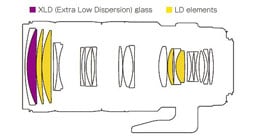 | |
Size (diam. x length): 86 x 188 mm (3.4 x 7.4 in.). Size is roughly the same as the competition. The lens does not change length during zooming or focusing. [0]
Weight: 1,470 g (3.2 lb.). Just a little heavier than the Sigma 70-200/2.8 OS. Mounted on a full frame body your shoulders will definitely feel the combined 2.4kg. [0]
Optics: 23 elements in 17 groups. 34 air/glass-surfaces provide a lot of opportunities for flares and ghosts. So a good coating is needed to suppress unwanted reflections. The cross-section shows five low dispersion elements. [0]
Closest focus distance/max. magnification: 1.3 m (4.3 ft.) / 1:8. In my test I was able to go down to 1: 7.4. This meager magnification also means that the effective focal length shrinks some 30% when focusing close. Similar to what the rivals from Sigma and Nikon achieve. [0]
Filter-thread: 77mm = standard with most pro-lenses [+]
IS: Yes, called VC (vibration compensation) = great! At focal lengths beyond 100mm and with today’s high resolution sensors image stabilization is an indispensable feature. Nikon, Canon, and Sigma have it already. [+]
AF: USD (ultrasonic silent drive), so it does work on D60/3×00/5×00-bodies, manual-focus override by turning the focus ring. [+]
Covers full frame/FX or smaller = very good [+]
Price: around 1350 EUR new (incl. 19% VAT) = not cheap. The alternative from Sigma is 33% cheaper. See above for the latest pricing. [-]
Comes with no case at all, but the lens-shade is included, reversible for transport, and the lens-caps are similar to Nikon’s standard. [0]
Distance information is relayed to the camera, so the Nikon body can do all the advanced exposure-related stuff with this lens. But this is true for all alternatives too. [+]
Aperture ring = no, just like all competitors. [0]
Sealing: yes! Including a rubber grommet at the lens-mount. [+]
The score in the “features-department” is 1[-]/6[0]/6[+]. The minus-point being the price. Although to be fair, the offerings from Nikon, Sony, and Canon are at least 500 EUR more expensive.
Alternatives
:
– From the third-party manufacturers there’s only one alternative: The Sigma AF 70-200mm 2.8 EX DG APO HSM OS is the cheapest way (around 950 EUR) to get a stabilized 70-200mm f2.8 zoom. And it earned a Recommended rating too. See my Sigma 70-200 f2.8 OS review.
– For Nikonians there are two alternatives, both of which I have reviewed: See my AF-S 70-200mm 2.8G ED VR II review for the professional version and my Nikon’s AF-S VR 70-200mm 4.0G ED VR review for the cheaper and lighter version. Both lenses bracket Tamron’s lens in price and earned a Highly Recommended rating in my reviews. So Tamron seems caught between a rock and a hard place.
– For Canon-users there are also two alternatives: The Canon EF 70-200mm 2.8 L IS II USM or the Canon EF 70-200mm 4.0 L IS USM. Similar to Nikon’s offering their f2.8 version is more expensive than Tamron’s zoom, but the f4.0 version is considerably cheaper.
| Alternative 70-200mm lenses | ||||
Nikon 70-200mm f4 | Sigma 70-200mm f2.8 OS | Nikon 70-200mm f2.8 II | ||
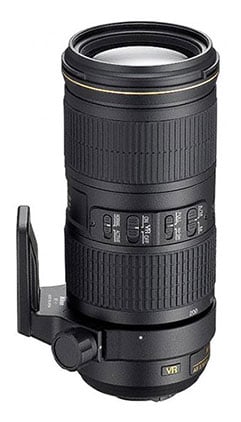 | 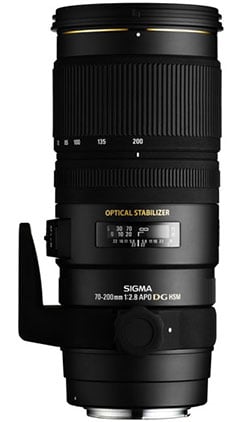 | 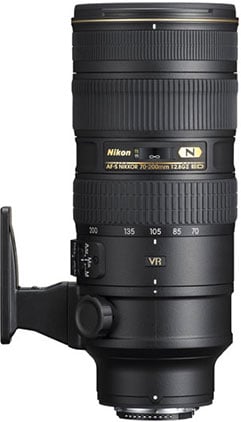 | ||
Focus, build quality, and image stabilization
Focus accuracy and repeatability is critical to consistently produce sharp shots. Repeatability (the accuracy of focus on the same subject after repeated focus-acquisition) of this lens is good with only one outlier over a series of 120 shots. And there is no performance variation whether the lens focuses coming from infinity or from minimum focus distance. The lens focuses at around 0.7 sec from infinity to 1.4m which is a little slower than the Nikon 70-200/2.8 at 0.6 sec.
The focus ring has no slack/play between its movement and the focus-action. It has a throw of around 130 degrees, which makes accurate focus wide open up to 150mm easy. The position of the focus ring and the zoom-ring are reversed from their respective positions on the Nikon 70-200/2.8 but at least they turn into the same direction as Nikon’s rings. The focus ring is the smaller of the two but still good enough to grip, movement is a little stiff. Zoom-action is smoother and the throw of the zoom-ring at only 60 degrees is pretty short. AF-operation is audible from the outside, and if you record video with the built-in microphone every focus-movement starts and stops with a slight “tock”. But between starting and stopping the AF-drive can hardly be heard in-between. The VR-system is quiet on the outside on barely records on video. And shaking the lens produces hardly any noises. All-in-all this is the quietest zoom I had so far on the D800.
Focus breathing is very visible: If you focus closer, the viewing angle becomes larger, the magnification smaller.
In general the impression of build quality is that of a pro-level lens: A high quality metal/plastic construction combined with nine rounded aperture blades and weather sealing. The sturdy tripod-collar and mount weighs a massive 185g and can be completely removed from the lens without having to detach the lens from the camera first.
To test the effectiveness of the image stabilization I did a series of over 170 test-shots hand-held at 200mm with VC=ON at 1/50, 1/25 and 1/13 sec and with VC=OFF at 1/200 sec. Rating the sharpness of those images at 100% magnification on a scale from 0 to 5 and comparing the samples of images with VC=ON and VC=OFF indicates that this lens gives you an advantage of about 3 stops.
That is very good! But there was a very irritating “warm-up” phase with the VC: It took about two to three shots at room temperature before VC was properly locking on target. And if you pause for a minute “warm-up” started anew with the first one or two shots being unusable. Unfortunately a second copy of the lens suffered from similar behavior with up to five shots needed for the VC to work as advertised.
So this looks like a design-problem or at least an issue with this batch of lenses. Additionally, on the outside with temperatures near 0 degrees Celsius during my test period I sometimes had the impression the VC didn’t work at all, or at least only after many more warm-up-shots. This renders VC almost useless because you hardly want to lose your first few shots. So if you get your copy of this lens make sure that VC wakes up immediately especially at lower temperatures!
Now it’s time to check out the results in my Tamron 70-200mm f2.8 VC quality and Tamron 70-200mm f2.8 VC sample images pages, or if you’d like to skip to chase, head straight for my verdict!



